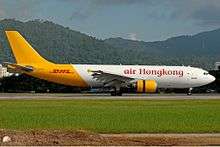Air Hong Kong
 | |||||||
| |||||||
| Founded | November 1986 | ||||||
|---|---|---|---|---|---|---|---|
| Commenced operations | 4 February 1988 | ||||||
| Hubs | Hong Kong International Airport | ||||||
| Frequent-flyer program | Cargo Clan Elite (by Cathay Pacific Cargo) | ||||||
| Fleet size | 14 | ||||||
| Destinations | 12 | ||||||
| Parent company | Cathay Pacific | ||||||
| Headquarters |
Hong Kong International Airport Hong Kong | ||||||
| Key people | Rupert Hogg (chairman) Liza Ng (COO) Gus Larard (Director of Flight Operations) | ||||||
| Website | www.airhongkong.com.hk | ||||||
| Air Hong Kong | |||||||||||||||
| Traditional Chinese | 香港華民航空公司 | ||||||||||||||
|---|---|---|---|---|---|---|---|---|---|---|---|---|---|---|---|
| Simplified Chinese | 香港华民航空公司 | ||||||||||||||
| |||||||||||||||
Air Hong Kong (Chinese: 香港華民航空) is an all-cargo airline based in Chek Lap Kok, Hong Kong, with its main hub at Hong Kong International Airport. The airline operates an express freight network to 12 destinations in nine countries, including China, Japan, Malaysia, Philippines, Republic of China (Taiwan), Singapore, South Korea, Thailand and Vietnam. It has a fleet of Airbus A300-600F General Freighters, which the airline was the launch customer of this new variant. Its head office is located on the fourth floor of the South Tower of Cathay Pacific City.[1]
Air Hong Kong was founded in November 1986 by three local businessmen and commenced charter services with a Boeing 707-320C freighter on 4 February 1988. In June 1994, Hong Kong's largest carrier, Cathay Pacific acquired 75% holdings of the airline; and acquired the remaining 25% in February 2002. In October, Cathay Pacific entered into a joint venture with DHL Worldwide Express (DHL), that eventually saw DHL take a 40% stake in the cargo airline, while Cathay Pacific retained the other 60% holding.
On July 7, 2017, Cathay Pacific announced that it would be acquiring DHL's stake in the airline.[2]
History

Air Hong Kong was established in November 1986 by three local businessmen from London's Stansted Airport, which included Roger Walman. Roger teamed up with Tomas Sang from Hong Kong to help fund the business. The airline commenced charter services with a Boeing 707-320C freighter on 4 February 1988, to Bombay (now known as Mumbai), Britain and Kathmandu; and scheduled services began on 18 October 1989. By early 1990, the airline had two Boeing 707-320C and operated a scheduled cargo service to Manchester, with traffic rights to Auckland, Brussels, Fukuoka, Guam, Melbourne, Nagoya, Osaka, Perth, Pusan, Singapore, Sydney, Vienna and Zurich.[3][4] Schedule cargo service to Nagoya was introduced and new traffic rights to Hanoi and Ho Chi Minh City granted by April 1991.[5] In March 1992, Air Hong Kong was granted additional traffic rights to Cairns, Darwin, Dhaka, Dubai, Kathmandu, Kuala Lumpur and Townsville. By March 1993, the airline operated scheduled cargo services to Brussels, Dubai, Ho Chi Minh City, Manchester, Nagoya and Singapore with a fleet of two Boeing 747-100SF and one Boeing 707-320C freighters.[6]
Polaris Aircraft Leasing, a subsidiary of General Electric Capital, entered into agreement in 1993 to suspend lease payments on the airline's three Boeing 747-100SFs in return for an option to buy up to 49 percent of the airline in January 1995. However, Cathay Pacific acquired 75 percent of the airline's shares for HK$200 million in June 1994 and the option was cancelled.[7][8] Facing weak demands and heavy financial losses, the airline was forced to terminate the lease on its Boeing 707-320C and one of its Boeing 747-100SF on November 1994 and January 1995, respectively, with only two Boeing 747-100SFs remaining.[9] By 2000, the airline had a fleet of three Boeing 747-200Fs with scheduled cargo services to Brussels, Dubai, Manchester and Osaka.[10]
The airline's parent, Cathay Pacific, acquired the remaining 25 percent of the airline's shares in February 2002 and became a wholly owned subsidiary. An operational restructure followed on 1 July, where Air Hong Kong ceased services to Brussels, Dubai and Manchester to focus on services in Asia. In October 2002, Cathay Pacific entered into a joint venture agreement with DHL Worldwide Express (DHL) by selling a 30 percent stake in the cargo airline in exchange for funds to purchase medium-size freighters to operate DHL's network in the Asia-Pacific region from Hong Kong. The airline set aside $300 million to purchase five freighters by 2004 and another $100 million towards at least three more freighters by 2010. In March 2003, Cathay Pacific sold another 10 percent stake to DHL and retained 60 percent of the airline.[8][11]
Air Hong Kong was the launch customer for the Airbus A300-600F General Freighter, which is a new variant of the Airbus A300-600F. This new variant has a cargo loading system capable of handling virtually every type of container and pallet, and a side door at the rear of the lower deck capable of handling large items of general freight. The airline took its first delivery of this new aircraft in September 2004, with the eighth and final aircraft delivered on 22 June 2006. The new freighters were powered by two General Electric (GE) CF6-80C2 engines and signed a 14-year Maintenance Cost Per Hour (MCPH) programme with GE on 25 January 2005.[12][13][14]
In November 2007, Air Hong Kong received an Award for Operational Excellence by the aircraft manufacturer Airbus for achieving an overall best performance on aircraft utilisation, operational reliability and average delay time.[15]
Destinations
.jpg)
Air Hong Kong operates cargo flights to the following destinations as of 7 May 2010:[16][17]
| Country | City | Airport | Notes | Refs |
|---|---|---|---|---|
| China | Beijing | Beijing Capital International Airport | ||
| China | Shanghai | Shanghai Pudong International Airport | ||
| Hong Kong | Hong Kong | Hong Kong International Airport | Hub | |
| Japan | Nagoya | Chubu Centrair International Airport | ||
| Japan | Osaka | Kansai International Airport | ||
| Japan | Tokyo | Narita International Airport | ||
| Malaysia | Penang | Penang International Airport | ||
| Philippines | Manila | Ninoy Aquino International Airport | ||
| Singapore | Singapore | Singapore Changi Airport | ||
| South Korea | Seoul | Incheon International Airport | ||
| Taiwan | Taipei | Taipei Taoyuan International Airport | ||
| Thailand | Bangkok | Suvarnabhumi Airport | ||
| Vietnam | Ho Chi Minh City | Tan Son Nhat International Airport | ||
Fleet


The Air Hong Kong fleet consists of the following aircraft (as of June 2018):[18]
| Aircraft | In Service | Orders | Notes |
|---|---|---|---|
| Airbus A300-600F | 8 | — | Operated for DHL Aviation |
| Airbus A300-600RF | 2 | — | Operated for DHL Aviation |
| Airbus A330-300/P2F | 2 | — | Operated by ASL Airlines Ireland |
| Boeing 747-400BCF | 1 | — | |
| Total | 13 | 0 |
The airline was the launch customer for the Airbus A300-600F General Freighter, which was the new variant of the Airbus A300-600F.[19]
Former Fleet
| Aircraft | Total | Introduced | Retired | Notes |
|---|---|---|---|---|
| Boeing 707-320C | Unknown | Unknown | Unknown | |
| Boeing 727-200F | Unknown | Unknown | Unknown | |
| Boeing 747-100SF | 4 | 1991 | 1996 | |
| Boeing 747-200F | 1 | 1994 | 1996 | |
| Boeing 747-200SF | 3 | 1997 | 2004 | |
| Boeing 747-400BCF | 3 | 2011 | 2018 | |
References
- ↑ "Directory: World Airlines." Flight International. 16–22 March 2004. 65. "AIR HONG KONG [LD1 (AHK) 4F South Tower; Cathay Pacific City, 8 Scenic Road, Hong Kong International Airport, Lantau, Hong Kong (SAR), China"
- ↑ "Cathay takes full control of freighter Air Hong Kong". South China Morning Post. Retrieved 2017-08-25.
- ↑ "News Scan" (PDF). Flight International. Reed Business Information. 26 March 1988. p. 7. Retrieved 29 July 2009.
- ↑ "World Airline Directory 1990" (PDF). Flight International. Reed Business Information. 14–20 March 1990. p. 56. Retrieved 29 July 2009.
- ↑ "World Airline Directory 1991" (PDF). Flight International. Reed Business Information. 27 March – 2 April 1991. p. 54. Retrieved 29 July 2009.
- ↑ "World Airline Directory 1993" (PDF). Flight International. Reed Business Information. 24–30 March 1993. p. 58. Retrieved 29 July 2009.
- ↑ "Cathay plans Air Hong Kong take-over" (PDF). Flight International. Reed Business Information. 30 March – 5 April 1994. p. 6. Retrieved 29 July 2009.
- 1 2 "Air Hong Kong". Air Hong Kong. Retrieved 29 July 2009.
- ↑ "Weak demand forces Air Hong Kong to cut fleet" (PDF). Flight International. Reed Business Information. 11–17 January 1995. Retrieved 29 July 2009.
- ↑ "World Airline Directory 2000" (PDF). Flight International. Reed Business Information. 4–10 April 2000. p. 60. Retrieved 29 July 2009.
- ↑ Fullbrook, David (15–21 October 2002). "Cathay and DHL seal cargo tie-up" (PDF). Flight International. Reed Business Information. p. 11. Retrieved 29 July 2009.
- ↑ "Air Hong Kong takes delivery of its first A300-600GF aircraft" (Press release). Air Hong Kong. 13 September 2004. Retrieved 29 July 2009.
- ↑ "Final A300-600GF delivered to Air Hong Kong" (Press release). Air Hong Kong. 28 June 2006. Retrieved 29 July 2009.
- ↑ "AHK Air Hong Kong Signs 14-Year MCPHSM Agreement" (Press release). General Electric. 25 January 2005. Retrieved 29 July 2009.
- ↑ "Air Hong Kong awarded for operational excellence" (Press release). Air Hong Kong. 15 November 2007. Retrieved 29 July 2009.
- ↑ "Air Hong Kong offers services via the Hong Kong hub to major cities in Asia". Air Hong Kong. Retrieved 7 May 2011.
- ↑ "Air Hong Kong flight schedule". Air Hong Kong. Retrieved 7 May 2011.
- ↑ "Global Airline Guide 2017 (Part One)". Airliner World (October 2017): 15.
|access-date=requires|url=(help) - ↑ "Air Hong Kong – the only all cargo airline of Hong Kong". Air Hong Kong. Retrieved 29 July 2009.
External links
| Wikimedia Commons has media related to Air Hong Kong. |